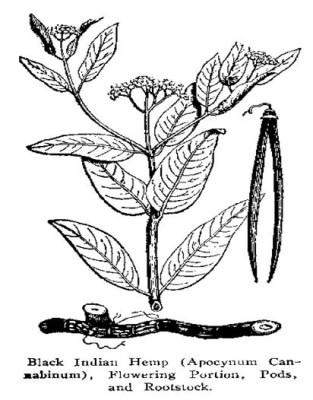Indian Hemp Dogbane (Apocynum cannibinum) is a plant species found in Cheshire that was used by Native Americans as medicine and as material for making thread, twine and rope.
A. cannibinum is a native perennial 3-5 feet tall with paired oval to lance-shaped leaves 2-4 inches long and with terminal greenish-white 5-lobed bell-shaped flowers. Its long narrow curved seed pods are arranged in pairs. In winter, the flower stalks and seed pods are a reddish-brown color. The seeds inside  the pods are attached to white flossy tufts much like those of Common Milkweed (Asclepias syriaca) and are dispersed by the wind after the pods have opened. Like milkweed, the live plant exudes a white latex-like sap when it is damaged. The plant typically grows near woodland borders, along paths, in clearings or in disturbed waste places like ditches and is often found fairly close to wetlands. Its natural range extends throughout the continental United States (except Alaska) and in Southern Canada.
the pods are attached to white flossy tufts much like those of Common Milkweed (Asclepias syriaca) and are dispersed by the wind after the pods have opened. Like milkweed, the live plant exudes a white latex-like sap when it is damaged. The plant typically grows near woodland borders, along paths, in clearings or in disturbed waste places like ditches and is often found fairly close to wetlands. Its natural range extends throughout the continental United States (except Alaska) and in Southern Canada.
Since the live plant is toxic for dogs and other animals to ingest, the genus name Apocynum is an appropriate latinized Greek term for “Go away dog!” The species name cannibinum means “hemp-like.” The plant has several other common names including dogbane, milkweed, honeybloom, bitter root, black hemp, hemp dogbane, lechuguilla, westernwall, Canadian hemp and Indian psycic. A. cannibinum is not the same “Indian Hemp” as marijuana (Cannibis sativa).
Wherever Indian Hemp Dogbane was found, early Native Americans used the strong fibers from its dead flower stalks for making cordage (thread, twine and rope). A. cannibinum bark fibers are stronger than those of any other herbaceous plant, including those of Common Milkweed (Asclepias syriaca), Stinging Nettle (Urtica dioica), and Wood Nettle (Laportea canadensis), which were also used for making cordage. In fact, a single strip of bark removed from a dead flower stalk is about as strong as modern light-test fishing line.
The cordage itself was used for making several items including baskets, pouches, twined bags, snares, nets, fishing line, quilts, linings, bowstrings and as lashing for shelter poles.
The use of A. cannibinum in New England and throughout its growing range in North America was well documented by early European explorers and settlers who attested to the durability of the plant’s fibers.
The live plant is highly toxic and contains the cardiac glycoside apocymarine which causes cardiac arrest if ingested. Children should not play with the milky-juiced stalks. Some people can get skin rash from contact with the sap. The dead plant parts are dry and are perfectly safe to handle.
Indian Hemp Dogbane can be found in several places in Cheshire: along the east edge of the Farmington Canal Heritage Trail between Lilac Court and South Brooksvale Road, the Boulder Knoll Community Farm, Cheshire Park (edge of the lake, east side of the park), Darcey Elementary School yard, and at the entrance of Roaring Brook Park.
Eric Nelson
Author: Eric Nelson is a local naturalist with a bachelor’s degree in biology from Southern Connecticut State University. He has studied and taught early Native American survival skills for several years.
Further Readings:
Brown, Tom Jr. 1983. Tom Brown’s Field Guide to Wilderness Survival. The Berkley Publishing Group, New York, NY.
Foster, Steven and Caras, Roger. 1994. Peterson Field Guides Venomous Animals & Poisonous Plants. Houghton Mifflin Company, Boston, MA and New York, NY.
NativeTech: Native American Cordage. www.Nativetech.org/cordage. Cordage Technology, including quotes from William Wood. 1634. New England’s Prospect. Reprinted 1977, University of Massachusetts, Amherst, MA.
Wood, William. 1634. New England’s Prospect. Reprinted 1977. University of Massachusetts, Amherst, MA.
Further Information:
Primitive Ways website. http://www.primitiveways.com/cordage_video.html. Cordage Making. “Cordage from Plant Fibers.” Video, Cordage Making. Narrator. Dino Labiste. Producer Bob Gillis. Video 1. What is Dogbane? Video 3. Extracting Dogbane Fibers. Video 4. Making Cordage From Dogbane Fibers.
Riggs, Jim. 1990. “How to Make Plant Fiber Cordage.” Video, Narrator. Jim Riggs. Northwestern Video Productions, Inc., Roseburg, OR
Image of plant: http://www.henriettes-herb.com/files/images/old/harding/harding-73.gif
Places to visit:
Institute for American Indian Studies
38 Curtis Road, Washington, CT 06793
(860)868-0518 (860) 868-1649 (fax)
10am-5pm // Mon-Sat 12pm-5pm // Sunday final admission at 4:30
Mashantucket Pequot Museum & Research Center
110 Pequot Trail
P.O. Box 3180
Mashantucket, CT 06338-3180
(800) 411-9671
Seasonal Days of Operation (Closed Nov. 30, 2014-Early May 2015)
Events for Eric Nelson
Talk at the Cheshire Historical Society: March 23, 2015 (7:30 PM), Subject: Indian Rope-Making
Cordage workshop, Cheshire Historical Society: Date & time to be announced

Recent Comments